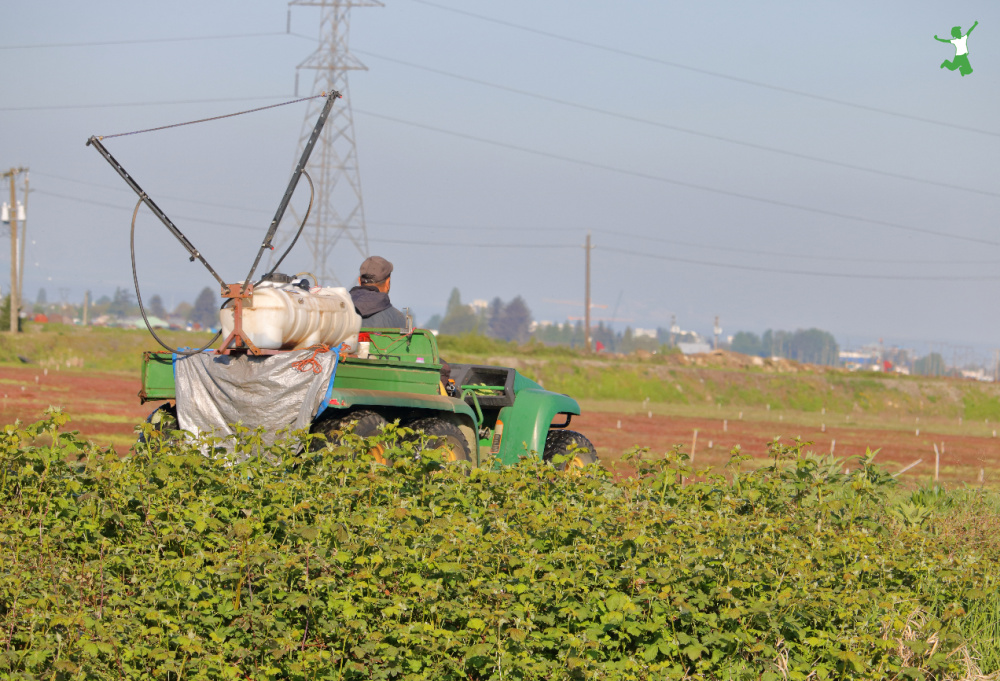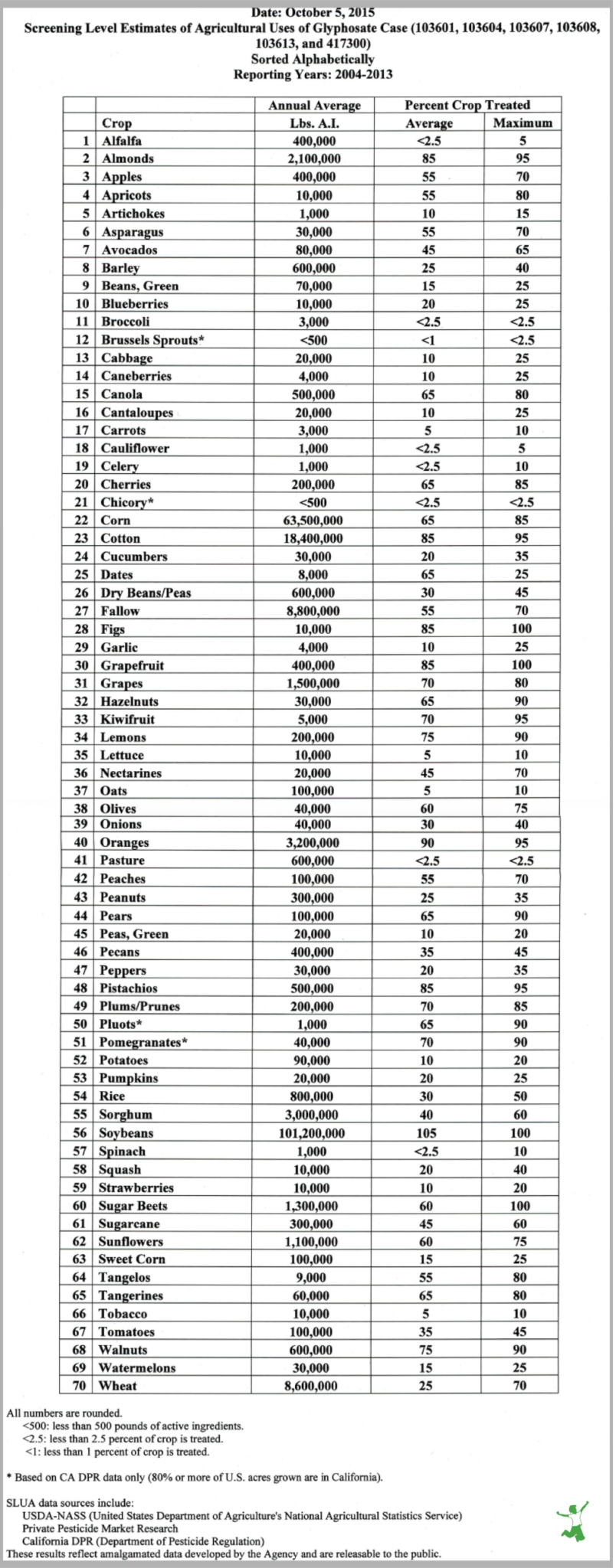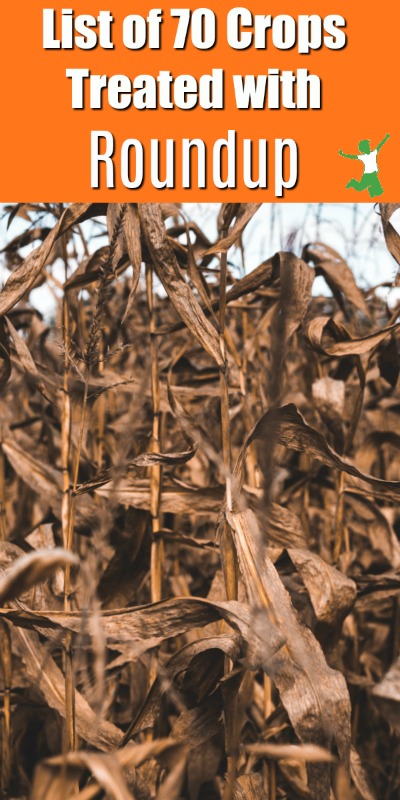Application of herbicides containing the toxic chemical glyphosate (Roundup) is common for dozens of conventional food crops, in many instances, just before harvest. The problem is not just wheat crops as commonly believed.

The application of herbicides as a (toxic) drying agent on wheat immediately before harvest is an established practice on many conventional farms.
The method was first suggested as early as 1980, becoming routine in North America over the past 15 years or so. Use is also widespread in the UK.
Applying herbicides like Roundup 7-10 days before harvest is viewed as especially helpful for wheat that ripens unevenly, a common occurrence.
It is also considered a helpful tool to initiate an earlier harvest when weather conditions threaten plant viability.
Other benefits are earlier ripening for earlier replanting and reducing the green material in the field. This puts less strain on farm machinery during harvest.
Farmers euphemistically call the practice “desiccation”. When used during wheat harvesting, it can result in a slightly greater yield by triggering plants to release more seeds.
The result?
Most non-organic wheat in North America is now contaminated with glyphosate, the active ingredient in Roundup and similar herbicides.
Glyphosate is Carcinogenic
A March 2015 report by the World Health Organization identified glyphosate as a probable human carcinogen. (1)
Several EU countries have banned Roundup as a result.
However, in North America, glyphosate use shockingly continues to remain popular in the conventional farming community.
As it turns out, the use of Roundup as a drying agent on wheat prior to harvest is just the tip of the iceberg.
Dozens of other food crops are subjected to dousing with glyphosate just prior to harvest as well.
This misguided and dangerous practice maximizes the herbicide residue on the food itself for the humans that eventually eat it!
Roundup. Not Just for GMO Crops
It is well known that Roundup is sprayed directly on GMO crops like corn and soy because they are genetically engineered to withstand the toxic onslaught without withering.
In fact, so much Roundup is used on GMO crops that herbicide-resistant “superweeds” are now a huge problem little more than a decade later. (2)
“If Roundup kills plants that aren’t genetically modified to resist it, then why use it on nonGMO crops?”
“Wouldn’t glyphosate kill a nonGMO crop?”
“Why would a farmer do this?”
Indeed, these common consumer questions indicate the ultimate irony of using Roundup for desiccation purposes on a food crop producing farm.
Killing the crop and/or the greenery around it is actually the whole idea. For crops like wheat, it evens up the field, allows for an earlier harvest, protects machinery and/or increases profit.
The bottom line?
Pre-harvest treatment of crops with glyphosate helps farmers to harvest their crops more efficiently and at less cost.
Crazy as it may seem, Roundup is used everywhere in the North American conventional food supply and not just on GMO crops or to kill weeds!
Glyphosate is applied directly to dozens of nonGMO food crops, in many cases, right before they are harvested.
This is the worst possible time to apply a herbicide because it causes the glyphosate to be absorbed into the food crop directly.
In other words, the glyphosate can’t be washed off later as it has become part of the food.
This toxin will then be ingested by those who consume it either directly as a “whole food” or via processed foods that contain it as an ingredient.
According to the Cornucopia Institute:
Ubiquitous in food production, glyphosate is used not just with row crops like corn, soybeans and wheat but also a range of fruits, nuts and veggies. Even spinach growers use glyphosate. (3)
Desiccating crops with herbicides before harvest is catching on in the UK as well where summers are wet and crops may ripen slowly and unevenly.
This can potentially lead to reduced yields and a lower-quality crop.
For example, 78% of the UK oilseed rape crop (similar to canola) is desiccated before harvest, but only 4% in Germany. (4)
Common Crops Desiccated with Glyphosate
The list of common crops desiccated with glyphosate within a few days of harvest is shockingly long!
Seventy crops are on the current EPA list which runs from 2004-2013. The complete list of crops is shown in the images below taken from an EPA memo from October 2015. (5)
What’s more, when the list is compared with a prior data snapshot, it shows that glyphosate use by farmers for key food crops alarmingly continues to grow. (6)
Glyphosate use by farmers averages 70% or more for some crops.
These include almonds, walnuts, figs, plums, prunes, grapes, kiwi, lemons, grapefruit, pistachios, and pomegranates.
Note: I could not find a more recent list than 2004-2013. However, given the results of glyphosate testing by Moms Across America in the past couple of years, it seems the list has expanded rather than contracted! More on this below.

How Glyphosate Destroys the Immune System
The currently accepted view is that glyphosate is not harmful to humans or any mammals.
This flawed view is so pervasive in the conventional farming community that Roundup salesmen have been known to foolishly drink it during presentations!
Just because Roundup doesn’t kill you immediately doesn’t make it safe though! The health-robbing effects are actually slow and insidious over months and years.
The decline in health occurs because glyphosate lethally disrupts the shikimate pathway found in beneficial gut microbes.
This probiotic pathway is responsible for the synthesis of critical amino acids and the cytochrome P450 (CYP) enzymes.
CYP enzymes are used by the body to detoxify the multitude of foreign chemical compounds and xenobiotics.
No matter where we live, we are exposed to these toxins in our modern environment every single day.
As a result, people exposed to glyphosate residue through the ingestion of food crops treated with it just before harvest become even more vulnerable to the damaging effects of other chemicals and environmental toxins they encounter!
This is possibly the worse result of glyphosate exposure. It makes you a sitting duck for any other toxins you encounter.
In addition, by significantly disrupting the functioning of beneficial bacteria in the gut, permeability issues related to the intestinal wall can occur over time.
This slow degradation of gut function encourages the development of a myriad of autoimmune disease symptoms.
These diseases include celiac disease, food allergies, Crohn’s, IBS, asthma, ulcerative colitis, MS, lupus, eczema, cancer, and the list goes on and on.
Glyphosate Million Dollar Question
Hence the chicken and egg question:
Is gluten in the wheat really the problem or is it actually the glyphosate residue sprayed on the wheat?
The same can be said for other foods.
Is it really the food(s) that are triggering an autoimmunity problem or the glyphosate that is being sprayed on it?
How Much Roundup Residue Are We Eating?
Consumers are increasingly alarmed by the monstrous rise in the use of glyphosate-containing herbicides on food crops.
In the United States, they are calling for testing of residues to determine if the levels are safe. Such testing is done for other agrichemicals, why not Roundup?
Unfortunately, while the FDA supposedly began testing for glyphosate residue in food in 2016, the results are questionable at best. (7)
Fortunately, private groups are filling the data gap, and the results are eye-opening.
For example, Moms Across America has found shocking levels of Roundup residue in processed food. Most recently, chickpea pasta was tested with the highest amount of glyphosate ever recorded. (8)
Note that chickpeas aren’t even on the Roundup crop list above 🤯
Thus, the complete list of foods with gut-damaging Roundup residues is far longer than believed.
The reality is that your only protection is to insist on organically produced food as much as possible.
And….for non-organic produce, be sure to buy it from local farmers ONLY with whom you are familiar with their growing practices.
The list of crops desiccated with glyphosate is far too long (and seemingly more extensive than is being revealed) and the risk to health far too high to consider otherwise.
(1) Widely Used Herbicide Linked to Cancer
(2) EPA Watchdog to Investigate Monsanto GMOs and Superweeds
(3) How Widespread Is the Use of Glyphosate in Our Food Supply?
(4) Glyphosate Renewal Group
(5) EPA Memo: Updated Screening Level Usage Analysis (SLUA) Report for Glyphosate Case PC
(6) EPA Memo: Updated Screening Level Usage Analysis (SLUA) Report in Support of Registration Review of Glyphosate
(7) FDA to Start Testing for Glyphosate in Food
(8) Moms Across America: Data on Toxins









“Roundup salesmen are commonly known to drink Roundup”…..really? I wonder how many of the cancer patients I took care of all those years were roundup salesmen. I am so glad to be retired from our Healthcare Cartel. The worst part of all of these is that there are so many willfully ignorant people . Information is there for the taking. Monsanto is in bed with the controllers of truthful information, but still, with massive reading, the truth seeps out.
People need to return to gardening to reduce exposure as much as possible. Food can even be grown on patios and balconies, in containers.
It’s worse than this. According to the government’s own studies, glyphosate was found even in organic oat cereals, often in higher concentrations than in non organic cereals. If it’s in oats it’s surely in all the other crops listed. It seems that water and soil runoff are contaminating the crops, as well as air drifting to organic areas where food is grown. Probably the greatest source of contamination is soil erosion washing fertilizers and pesticides into water supplies. Obviously, if one avoided the foods the are listed on this chart even in organic form, one would have a diet that no one could stick to.
Fantastic in depth information on Pre Harvest Roundup – Glyphosate. it all scared me and infuriated me. Most of all learning that Glyphosate is also used on Non GMO foods. Second, is wheat in breads is contaminated and most likely cereals. We as The People need to try to Problem Solve how to stop this. Earth Day, a day to celebrate a healthy earth is on: April 22, 2019. Can we march? Can we picket? Make calls to people who have great voices to speak up for us? Your with Weston A Price Foundation. There is another and probably more: Mission Possible International with Mrs. Betty Martini. She is a fantastic caring woman who has work endlessly on stopping GMO Foods, plus Fluorides and more harmful things
We can make a loud noise to stop: Bayer, DuPont, Dow Chemical, Syngenta, BASF. .Abbot Company, Educate people. Lots of good scientists have spoken out and their words can teach, even everyday people. Create TV even has great Non GMO Teachers: Growing A Greener World is just one. praise You and Thank you. Remember: Earth Day, April 22, 2019
So what do poor people and lower middle class people do? They can’t afford organic. And many of these people are minorities. How do we enable them to purchase organic foods?
I am fuming beyond words..enragebut..
I am an organic vegetarian.
but eat some fish..cheese. Now I read labels carefully..and am an advocate for the small farmer..not these corrupt BigAg Corps. that are obviously poisoning the general pooulation. EVERYONE:
CALL..EMAIL THESE MONSANTO EXECS..AS WELL AS CONGRESS..Mr.T..anyone who can reverse this practice..NOW!!.
DO NOT ALLOW YOUR KIDS TO EAT WHEAT UNLESS YOU ARE CERTAIN IT IS ORGANIC!!
Please check into the nematicide-methyl bromide. Since global warming is so prevalent, it is been used heavily used inspite of the fact that it was outlawed in 2009. Very toxic.
Nope. Sadly, Non-GMO just means no genetically engineered ingredients. Conventional foods often are contaminated with many synthetic chemical ‘icides including Roundup, 2,4-D, Dicamba and many more man made poisons.
Unless it’s organic, odds are it’s contaminated with synthetic chemical pesticides. Eve organics is now a little contaminated, just like our water, land and bodies. :'(
I’ve been trying to find out if a product is certified by the Non-GMO Project, does that mean it has not been sprayed with Roundup for pre-drying?
A Non-GMO Certified product is NOT necessarily organic, and in that case, it most certainly could come from crops desiccated with Roundup. Best to get both organic AND NonGMO Certified because an organic product could still be 5% or less GMO and a NonGMO Certified project product could have pesticide residue.
Werner Baumann is the CEO of Bayer, parent company of Monsanto. Here is a link to the Ag division contact form. https://www.cropscience.bayer.com/en/support/contact-us
Ask him if his children or grandchildren should play next to fields being sprayed with Round-Up, much less eat the products. Safe foods are harder and harder to find … and afford.